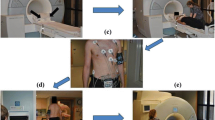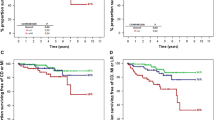Abstract
Previous studies have documented the prognostic utility of left ventricular ejection fraction response to exercise primarily in populations without prior myocardial infarction. We undertook a study to assess the prognostic utility of exercise left ventricular ejection fraction and segmental wall motion response during exercise radionuclide ventriculography in coronary artery disease patients with and without prior myocardial infarction. Methods. We examined the comparative prognostic utility of left ventricular ejection fraction and segmental wall motion response during upright bicycle exercise radionuclide ventriculography in 419 coronary artery disease patients with (n=217) and without (n=202) prior myocardial infarction using univariate and multivariate hierarchical regression analyses. Results. During an average followup period of 61 months, 96 patients (23%) suffered cardiac events, including 55/217 (25%) of the patients with prior myocardial infarction and 41/200 (21%) of the patients without prior myocardial infarction (p=ns). Both cumulative Kaplan-Meier survival analyses and stepwise hierarchical Cox survival analyses demonstrated that peak left ventricular ejection fraction <55% was a significant predictor of cardiac events in patients without prior myocardial infarction (p=0.04), whereas an exercise wall motion worsening score ≥ 2 was a significant predictor in patients with a prior myocardial infarction (p=0.0001). Conclusions. The prognostic utility of exercise radionuclide ventriculography variables differ according to the presence or absence of prior myocardial infarction. Global function, assessed by peak left ventricular ejection fraction, adds the greatest prognostic information in patients without prior myocardial infarction, whereas regional function, assessed by exercise wall motion worsening, is the best predictor among patients with prior myocardial infarction.
Similar content being viewed by others
References
Bonow, RO, Kent KM, Rosing DR, et al. Exercise-induced ischemia in mildly symptomatic patients with coronary-artery disease and preserved left ventricular function: identification of subgroups at risk of death during medical therapy. N Engl J Med 1984; 311: 1339-45.
Pryor EB, Harrell FE, Lee KL, et al. Prognostic indicators from radionuclide angiography in medically treated patients with coronary artery disease. Am J Cardiol 1984; 53: 18-22.
Hung J, Goris ML, Nash E, et al. Comparative value of maximal treadmill testing, exercise thallium myocardial perfusion scintigraphy and exercise radionuclide ventriculography for distinguishing high-and low-risk patients soon after acute myocardial infarction. Am J Cardiol 1984; 53: 1221-7.
Mazzota G, Bonow RO, Pace L, Brittain E, Epstein SE. Relation between exertional ischemia and prognosis in mildly symptomatic patients with single or double vessel coronary artery disease and left ventricular dysfunction at rest. J Am Coll Cardiol 1989; 13: 567-73.
Breitenbucher A, Pfisterer M, Hoffman A, Burckhardt D. Long-term follow-up of patients with silent ischemia during exercise radionuclide angiography. J Am Coll Cardiol 1990; 15: 999-1003.
Lee KL, Pryor DB, Pieper KS, et al. Prognostic value of radionuclide angiography in medically treated patients with coronary artery disease: a comparison with clinical and catheterization variables. Circulation 1990; 82: 1705-17.
Zhu W, Gibbons RJ, Bailey KR, Gersh BJ. Predischarge exercise radionuclide angiography in predicting multivessel coronary artery disease and subsequent cardiac events after thrombolytic therapy for acute myocardial infarction. Am J Cardiol 1994; 74: 554-9.
Rozanski A, Berman DS, Gray R, et al. Preoperative prediction of reversible myocardial asynergy by postexercise radionuclide ventriculography. N Engl J Med 1982; 307: 212-6.
Harris PJ, Behar Victor S, et al. The prognostic significance of 50% coronary stenosis in medically treated patients with coronary artery disease. Circulation 1980; 62: 240-7.
Staniloff HM, Forrester JS, Berman DS, Swan HJC. Prediction of death, myocardial infarction and worsening chest pain using thallium scintigraphy and exercise electrocardiography. J Nucl Med 1986; 27: 1842-8.
Ladenheim ML, Pollock BH, Rozanski A, et al. Extent and severity of myocardial hypoperfusion as predictors of prognosis in patients with suspected coronary artery disease. J Am Coll Cardiol 1986; 7: 464-71.
Mark DB, Shaw BA, Harrell FE, et al. Prognostic value of a treadmill exercise score in outpatients with suspected coronary artery disease. N Engl J Med 1991; 325: 849-53.
Bolognese L, Rossi L, Sarasso G, et al. Silent versus symptomatic dipyridamole-induced ischemia after myocardial infarction: clinical and prognostic significance. J Am Coll Cardiol 1992; 19: 953-9.
Multicenter Postinfarction Research Group: Risk stratification and survival after myocardial infarction. N Engl J Med 1983; 309: 331-6.
Rapaport E, Remedios P. The high risk patient after recovery from myocardial infarction: recognition and management. J Am Coll Cardiol 1983; 1: 391-400.
Bigger JT, Fleiss JL, Miller JP, Rolnitzky LM, and Multicenter Postinfarction Research Group: The relationships among ventricular arrhythmias, left ventricular dysfunction, and mortality in the 2 years after myocardial infarction. Circulation 1984; 69: 250-8.
Miller TD, Taliercio CP, Zinsmeister AR, Gibbons RJ. Risk stratification of single or double vessel coronary artery disease and impaired left ventricular function using exercise radionuclide angiography. Am J Cardiol 1990; 65: 1317-21.
Ladenheim ML, Kotler TS, Pollack BH, Berman DS, Diamond GS. Incremental prognostic electrocardiography and myocardial perfusion scintigraphy in suspected coronary artery disease. Am J Cardiol 1987; 59: 270-7.
Iskandrian AS, Chaek SC, Heo J, Stanberry CD, Wasserleben V, Case V. Independent and incremental prognostic value of exercise single-photon emission computed tomographic (SPECT) thallium imaging in coronary artery disease. J Am Coll Cardiol 1993; 22: 665-70.
Friedman J, Berman DS, Kiat H, et al. Rest and treadmill exercise first-pass radionuclide ventriculography: validation of left ventricular ejection fraction measurements. J Nucl Card 1994; 4: 382-8.
Borges-Neto S, Coleman RE, Potts JM, Jones RH. Combined treadmill exercise radionuclide angiocardiography and SPECT perfusion studies for assessment of coronary artery disease. Semin Nucl Med 1991; 21: 223-9.
Palmas W, Friedman J, Kiat H, Silber H, Berman DS. Improved identification of multiple vessel coronary artery disease by addition of exercise wall motion analysis to Tc-99m sestamibi myocardial perfusion SPECT [abstract]. J Nucl Med 1993; 34: 5A.
Moriel M, Rozanski A, Klein J, Berman DS, Bairey Merz CN. Women, prognosis and coronary artery disease: the limited efficacy of exercise radionuclide ventriculography. Am J Cardiol 1995; 76: 1030-5.
Picano E, Severi S, Michelassi C et al. Prognostic importance of dipyridamole-echocardiography test in coronary artery disease. Circulation 1989; 80: 450-7.
Jaarsma W, Visser CA, Kupper AJF, Res JCJ, Van EEnige MJ, Roos JP. Usefulness of two-dimensional exercise echocardiography shortly after myocardial infarction. Am J Cardiol 1986; 57: 86-90.
Applegate RJ, Dell'Italia LJ, Crawford MH. Usefulness of two-dimensional echocardiography during low-level exercise testing early after uncomplicated acute myocardial infarction. Am J Cardiol 1987; 60: 10-14.
Limacher MC, Quinones MA, Poliner LR, Nel JG, Winters WL, Waggoner AD. Detection of coronary artery disease with exercise two-dimensional echocardiography: description of a clinically applicable method and comparison with radionuclide ventriculography. Circulation 1983; 67: 1211-18.
Author information
Authors and Affiliations
Rights and permissions
About this article
Cite this article
Moriel, M., Rozanski, A., Klein, J. et al. The differing prognostic utility of exercise radionuclide ventriculography in coronary artery disease patients with and without prior myocardial infarction. Int J Cardiovasc Imaging 13, 403–413 (1997). https://doi.org/10.1023/A:1005751510034
Issue Date:
DOI: https://doi.org/10.1023/A:1005751510034




